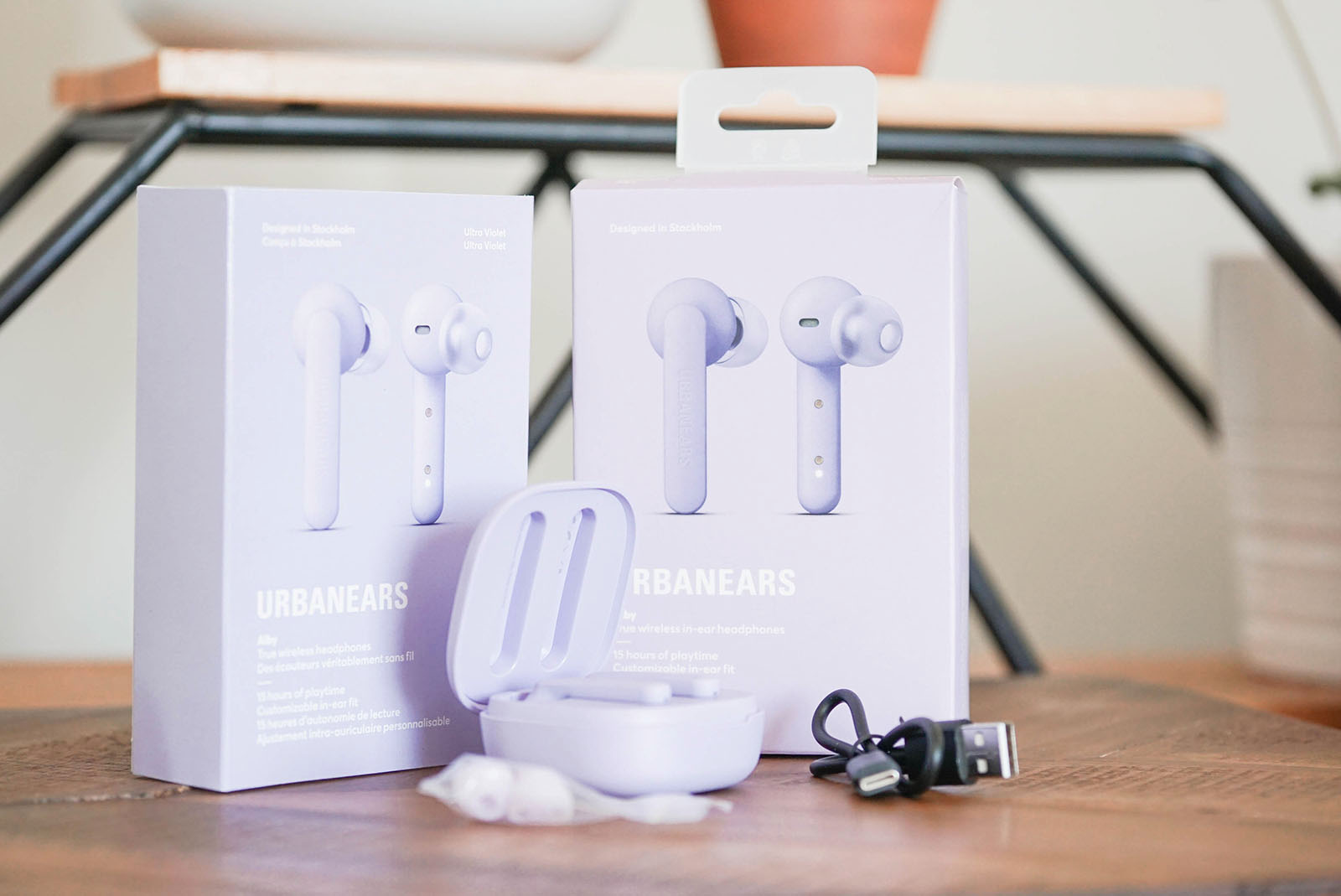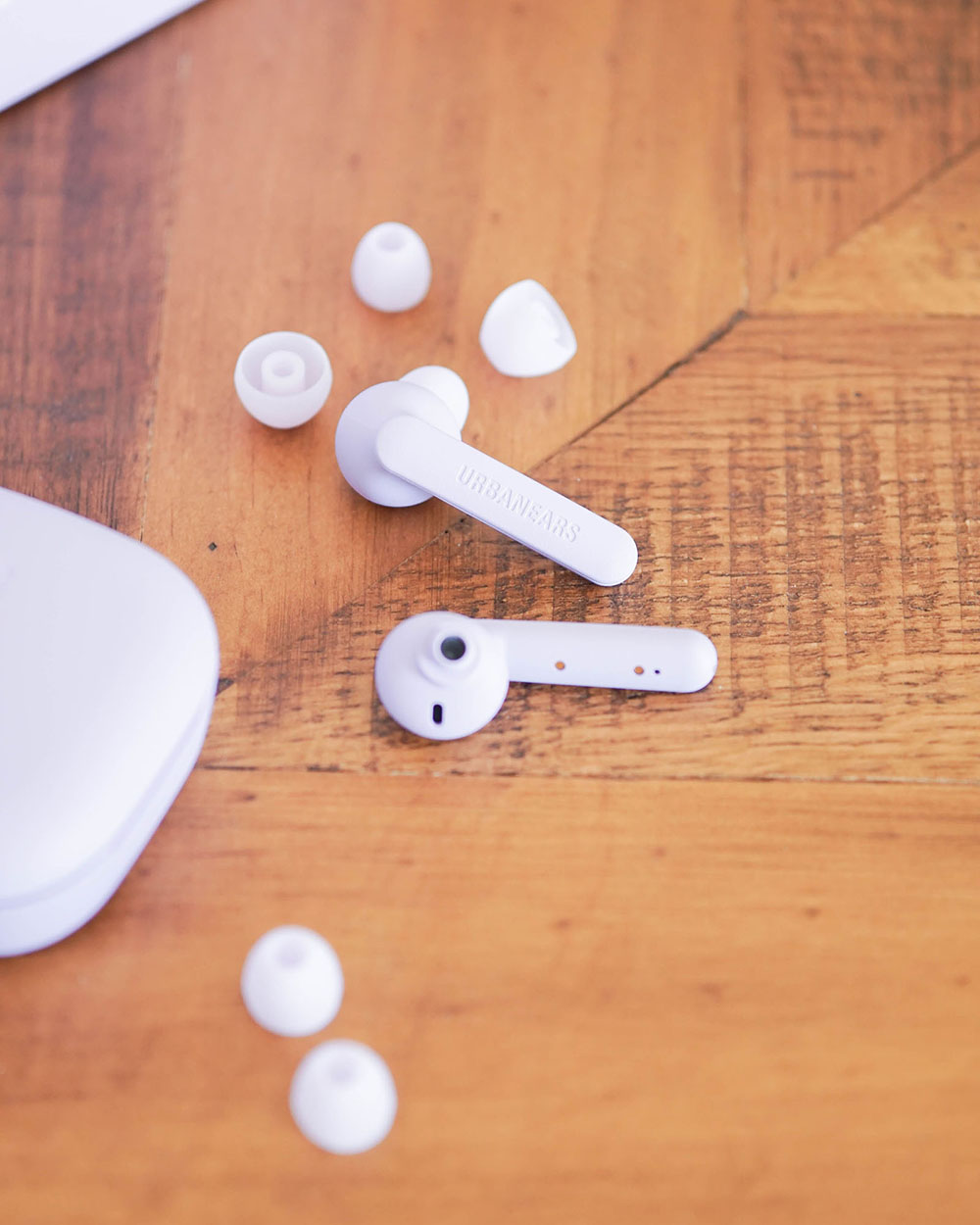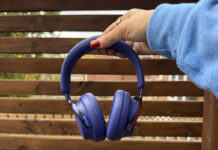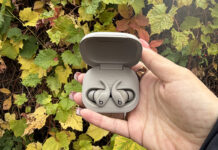
When you use the Urbanears Alby In Ear Sound Isolating Truly Wireless Headphones, you don’t have to sacrifice style for function. These beautiful, lightweight headphones offer all the freedom that you’d expect from a truly wireless earbud—with a level of comfort and sound isolation that makes it feel like you’re sitting in a studio booth.
What’s included with the Urbanears Alby in-ear sound isolating headphones?
Here’s what’s included in the box of the Urbanears Alby Sound Isolating Headphones.
- Left and right earbud
- Charging case
- USB-C charging cable
- Four silicone tips plus two more on the headphones
The Alby headphones are designed to fit snugly in your ear canal to block out external noise, which is why they come with three sizes of soft, comfortable silicone tips. Their truly wireless design connects to your device with Bluetooth 5.0, and offers IPX-4 sweat and splash resistance.
Like the Urbanears Luma Headphones, these headphones are lightweight and have a beautiful, matte finish. Their battery provides 3 hours of playtime per charge, and their case can store 4 additional charges for a total of 15 hours of play time.
I know most people are unlikely to own two different pairs of earbuds from the same brand, but as someone who does, I appreciate how easy Urbanears makes it to tell them apart! The in-ear Alby comes in a square charging case with rounded edges, while the Luma design’s charging case has a sturdy plastic loop on it.
It makes it easy to distinguish between the two in an instant. If I’m looking for better sound quality and sound isolation, I grab the Alby. If I need a long battery life above all else, I reach for the Luma. (While the Alby earbuds have a 15-hour battery life, the Luma design offers a whopping 25 hours—5 hours for each charge, plus 4 more in the case.) Both offer noise-filtering dual microphones on each earbud, plus wear-detect sensors as well as tap and voice controls.

How to use the Urbanears Alby headphones
Like the Urbanears Luma, I had one huge problem with the Urbanears Alby: they seem to exist solely to wreak havoc on my social life. These earbuds come with tap and voice controls to make your life easier, but their controls are super-sensitive—to a degree where they kept trying to place calls to random contacts on my behalf. Urbanears has its own setup instructions available; they tell you to remove the clear backing on each earbud, place them both back in the charging case, and then remove them simultaneously and wait for them to pair with each other before pairing them with your device.
My personal recommendation for using Alby in-ear headphones
I have a different recommendation. To use the Urbanears Alby In-Ear Sound Isolating Truly Wireless Headphones, first turn off your phone’s Voice Control function. This is critical. You can do this on an iPhone by going to Settings > Touch ID & Passcode > Voice Dial, or on an Android by going to Settings > Accessibility > Voice Access. Doing so won’t dissuade your headphones from trying to make calls, but it’ll prevent the process from reaching completion. After you turn off Voice Dial or Voice Access, then go on and follow the brand’s recommendations for use.
Stable Bluetooth connection
From there, everything else is easy. These earbuds quickly form a stable connection with my phone (thank you, Bluetooth 5.0). Their connection continues without a glitch throughout my entire house, even when I leave my phone on a different floor. I don’t experience any lag time between each earbud, or between my earbuds and my device. My only other recommendation is that you place these earbuds back into their case between uses; like their tap controls, Urbanears’ wear-detect sensors are very sensitive, and often leave my earbuds playing when they’re in a pouch or on a tabletop.

How sound-isolating are the Alby headphones?
This one is easy: very. The Urbanears Alby In-Ear Sound Isolating Truly Wireless Headphones do a fantastic job of creating a quiet, sound isolating environment.
I remember when truly wireless sound isolating headphones first hit the consumer market in a big way. Sound isolation used to be a luxury feature; something that frequent fliers would splash out a little extra money for while the rest of us listened to mind-numbing motors drone on for hours. It wasn’t until the 2010s that effective sound isolating features started popping up left and right at a regular consumer price point, and those first few years were a drag! My ears would ache after just an hour of use of the first sound-isolating headphones I tried, and my long hair would always pull the wired designs out of my ears.
Today, sound isolation is commonplace—and as Urbanears shows here, it can be extremely comfortable. The Alby headphones do a great job of blocking out noise, and come with three silicone tip sizes to customize the fit for your ears. (I often have to opt for kids’ earplugs, but Urbanears’ smallest tip size is just right.) Each of these in-ear headphones fits snugly and securely. They stay firmly in place when I’m cleaning or working out, and I’ll occasionally even pop them in without music to block out noises from around the house!
The Alby design is most effective, in my experience, at blocking out low-grade, constant noises: the hum of a refrigerator, the woosh of a busy street, or the high-pitched squeal of a plug-in. It muffles conversations, but doesn’t block out all noises. If my partner is standing in the same room as me, I can still hear his voice; however, making out the words can be difficult.

Sound quality of the Urbanears Alby headphones
When I wrote my review for the Urbanears Luma, I ran into more than just tap control issues. The Luma seemed prone to a loud, ringing noise when not in use, and sounded tinny with very little bass. Happily, I can say that my experience with Alby’s sound quality could not have been more different.
The Urbanears Alby Sound Isolating Headphones are not my first choice for melt-in-the-spot amazing sound quality. However, they are very immersive, and they offer a blend of comfort and sound quality that I adore. These headphones are close to being my holy grail for comfortable earbuds. I find myself reaching for them again and again, especially when I’m cleaning or cooking.
I do most of the cooking in our home, so I often find myself stuck in front of the stove. We have a noisy range hood that’s mounted into the wall (thanks, old-timey vintage kitchen), and as a result, I usually end up having to blast the volume when I’m cooking.
With the Alby in-ear headphones, however, sounds come through clearly. In noisy environments where I would have had to use my Apple AirPods at 90%, I can use the Alby at 20% instead and hear each podcast word or sound lyric just as crisply. Their excellent design loses very little in transmission, so while their sound quality falls below what one might get from something like a studio-quality speaker, it’s significantly better than the sound off of my tinny computer monitor or smartphone.

My experience with Urbanears Alby headphones
From their pastel violet tone to their secure fit, I really enjoy using the Urbanears Alby Headphones. I have to be extra careful to ensure I’m not making accidental Voice Control calls or tapping to unintentionally skip tracks, but for 15 hours of battery life and excellent sound isolation, it’s more than a worthwhile tradeoff.
These in-ear headphones feel like a must-have when I’m cleaning around the house and cooking dinner. They’re also great for casual use, like calling my grandma or watching Netflix while I work out. I can’t wait to enjoy their sound-isolating capabilities on my next plane or train ride.
Shop the Urbanears Alby In Ear Sound Isolating Truly Wireless Headphones at Best Buy.


